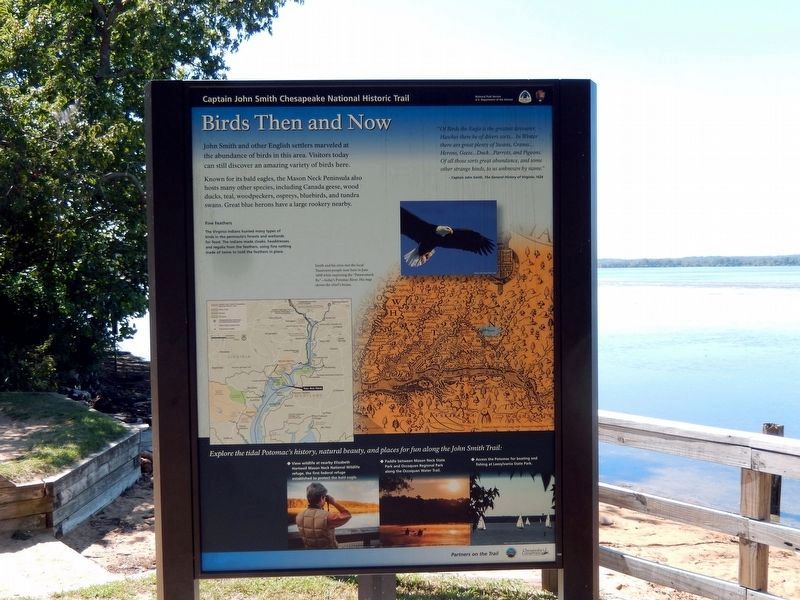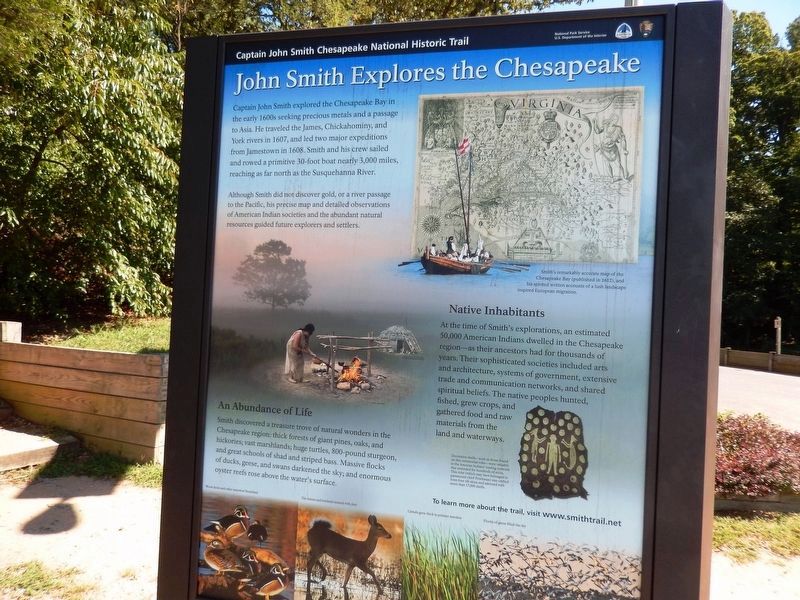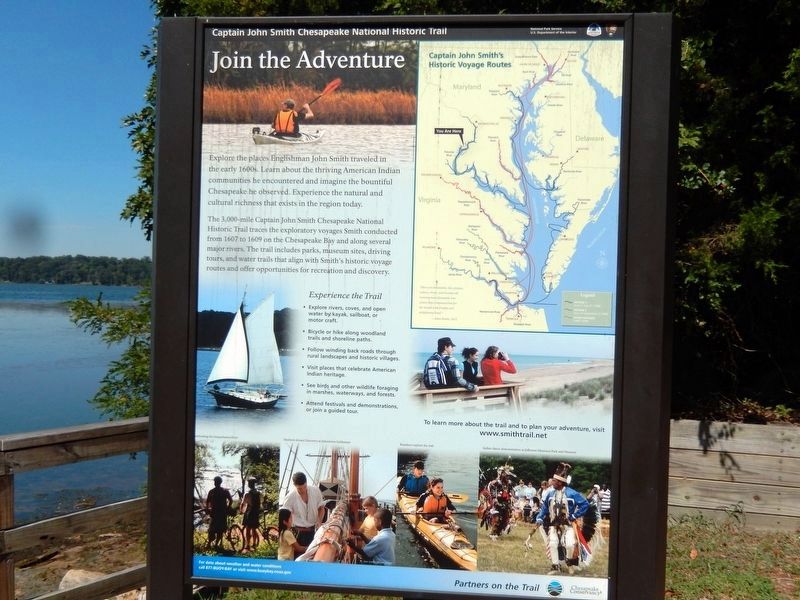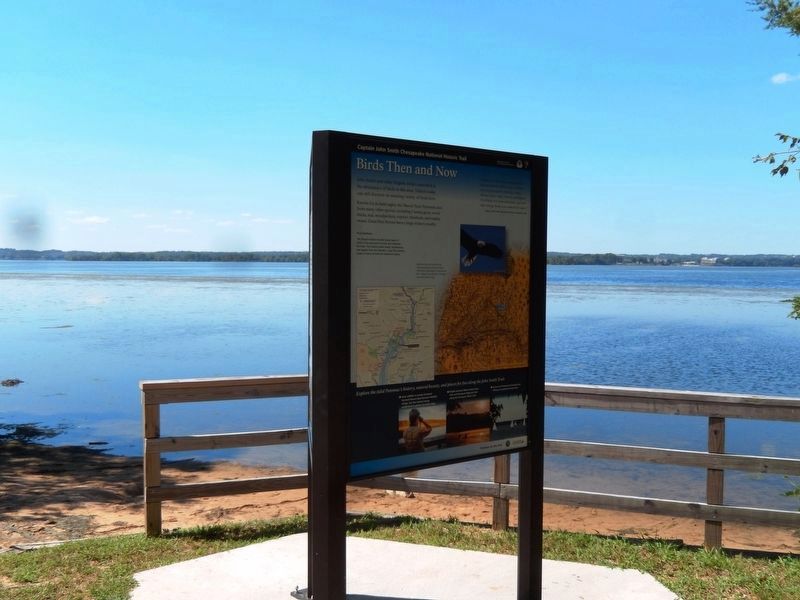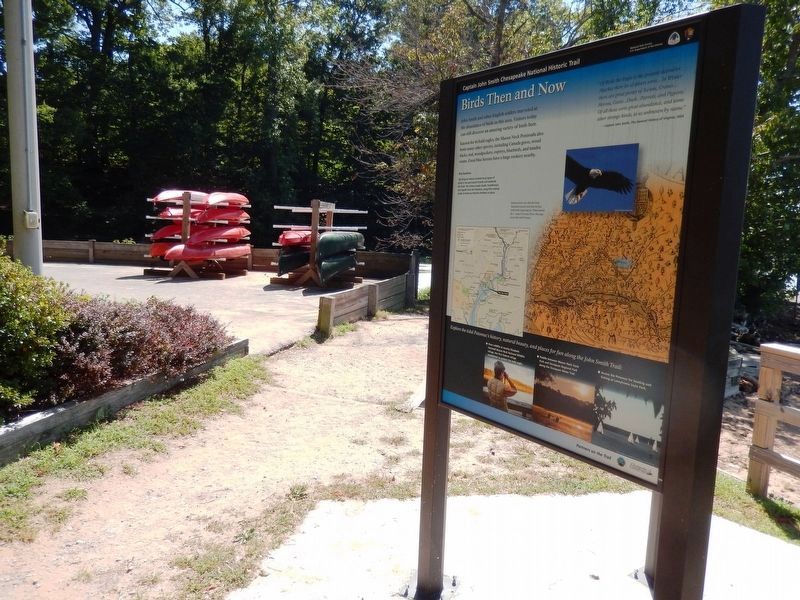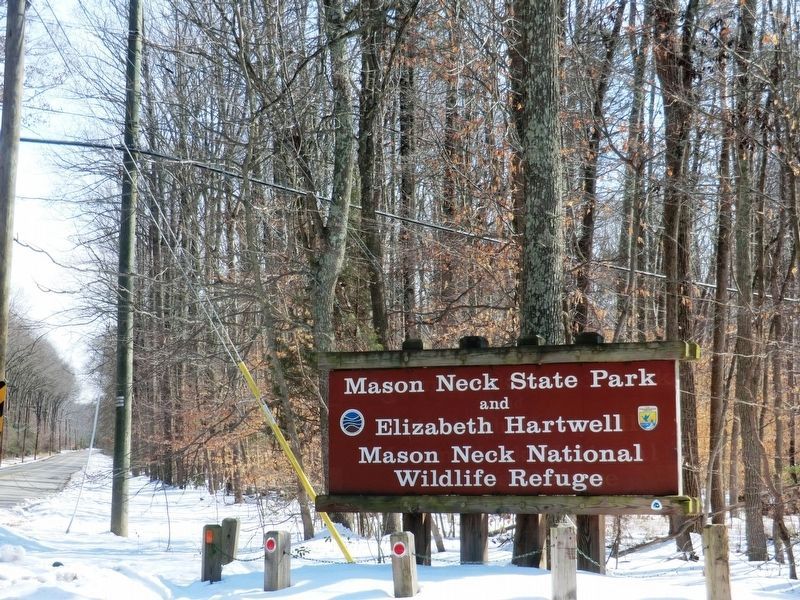Lorton in Fairfax County, Virginia — The American South (Mid-Atlantic)
Birds Then and Now
Captain John Smith Chesapeake National Historic Trail
— National Park Service, U.S. Department of the Interior —
(panel 1)
John Smith and other English settlers marveled at the abundance of birds in this area. Visitors today can still discover an amazing variety of birds here.
Known for its bald eagles, the Mason Neck Peninsula also hosts many other species, including Canada geese, wood ducks, teal, woodpeckers, ospreys, bluebirds, and tundra swans. Great blue herons have a large rookery nearby.
"Of Birds the Eagle is the greatest devourer. Hawkes there be of dives sorts…In winter there are great plenty of Swans, Cranes…Herons, Geese…Duck…Parrots, and Pigeons. Of all those sorts great abundance, and some other strange kinds, to us unknown by name.”
– Captain John Smith, The General History of Virginia, 1624
Fine Feathers
The Virginia Indians hunted many types of birds in the peninsula’s forests and wetlands for food. The Indian made cloaks, headdresses, and regalia from the feathers, using fine netting made of twine to hold the feathers in place.
(captions)
Smith and his crew met the local Tauxenent people near here in June 1608 while exploring the “Patawomeck flu”—today’s Potomac River. His map shows the chief’s house.
(sidebar)
Explore the tidal Potomac’s history, natural beauty, and places for fun along the John Smith Trail:
• View wildlife at nearby Elizabeth Hartwell Mason Neck National Wildlife refuge, the first federal refuge established to protect the bald eagle.
• Paddle between Mason Neck State Park and Occoquan Regional Park along the Occoquan Water Trail.
• Access the Potomac for boating and fishing at Leesylvania State Park.
(panel 2)
John Smith Explores the Chesapeake
Captain John Smith explored the Chesapeake Bay in the early 1600s seeking precious metals and a passage to Asia. He traveled the James, Chickahominy, and York rivers in 1607, and led two major expeditions from Jamestown in 1608. Smith and his crew sailed and rowed a primitive 30-foot boat nearly 3,000 miles, reaching as far north as the Susquehanna River.
Although Smith did not discover gold, or a river to the Pacific, his precise map and detailed observations of American Indian societies and the abundant natural resources guided future explorers and settlers.
Native Inhabitants
At the time of Smith's explorations, an estimated 50,000 American Indians dwelled in the Chesapeake region—as their ancestors had for thousands of years. Their sophisticated societies included arts and architecture, systems of government, extensive trade and communication networks, and shared spiritual beliefs. The native
people hunted, fished, grew crops, and gathered food and raw materials from the land and waterways.
An Abundance of Life
Smith discovered a treasure trove of natural wonders in the Chesapeake region: thick forests of giant pines, oaks, and hickories; vast marshlands, huge turtles, 800-pound sturgeon, and great schools of shad and striped bass. Massive flocks of ducks, geese, and swans darkened the sky; and enormous oyster reefs rose above the water's surface.
To learn more about the trail visit www.smithtrail.net
(captions)
Smith’s remarkably accurate map of the Chesapeake Bay (published in 1612), and his spirited written accounts of a lush landscape inspired European migration.
Decorative shells-such as those found on this ceremonial robe-were valuable in the American Indian’s trading network that extended for hundreds of miles. This robe (which may have belonged to paramount chief Powhatan) was crafted from four elk skins and adorned with more than 17,000 shells.
Wood ducks and other waterfowl flourished
The forests and lowlands teemed with deer
Cattails grew thick in pristine marshes
Flocks of geese filled the sky
(panel 3)
Join the Adventure
Explore the places Englishman John Smith traveled in the early 1600s. Learn about the thriving American Indian communities he encountered and imagine the bountiful Chesapeake he observed. Experience the natural and cultural richness that exists in the region today.
The 3,000-mile Captain John Smith Chesapeake National Historic Trail traces the exploratory voyages Smith conducted from 1607 to 1609 on the Chesapeake Bay and along several major rivers. The trail includes parks, museum sites, driving tours, and water trails that align with Smith's historic voyage routes and offer opportunities for recreation and discovery.
Experience the Trail
• Explore rivers, coves, and open water by kayak, sailboat, or motor craft.
• Bicycle or hike along woodland trails and shoreline paths.
• Follow winding back roads through rural landscapes and historic villages.
• Visit places that celebrate American Indian heritage.
• See birds and other wildlife foraging in marshes, waterways, and forests.
• Attend festivals and demonstrations, or join a guided tour.
To learn more about the trail and to plan your adventure, visit
www.smithtrail.net
(captions)
Captain John Smith’s Historic Voyage Routes
“Here are mountains, hils, plaines, valleys, rivers, and brookes all running most pleasantly into a faire Bay compassed but for the mouth with fruitful and delightsome land.”
– John
Smith, 1612
Overlooking the Susquehanna River
Students aboard Discovery at Jamestown Settlement
Kayakers explore the trail
Indian dance demonstration at Jefferson Patterson Park and Monument
Erected 2014 by National Park Service, U.S. Department of the Interior.
Topics and series. This historical marker is listed in these topic lists: Animals • Exploration • Native Americans • Settlements & Settlers. In addition, it is included in the Captain John Smith Chesapeake National Historic Trail series list. A significant historical month for this entry is June 1608.
Location. 38° 38.594′ N, 77° 11.991′ W. Marker is in Lorton, Virginia, in Fairfax County. Marker can be reached from High Point Road, 2.8 miles south of Gunston Road (Virginia Route 242/600). The marker is located near the boat launch in Mason Neck State Park. Touch for map. Marker is at or near this postal address: 7301 High Point Road, Lorton VA 22079, United States of America. Touch for directions.
Other nearby markers. At least 8 other markers are within 2 miles of this marker, measured as the crow flies. At Home in an Ecotone (here, next to this marker); Delaying Tactics (about 300 feet away, measured in a direct line); War in the Chesapeake (about 400 feet away); "Spirit of America" (about 500 feet away); Vision, Initiative, and Dedication
(about 600 feet away); The Nation's River (approx. 1.7 miles away); Elizabeth Hartwell Mason Neck National Wildlife Refuge (approx. 1.9 miles away); East Coast Radio Transmitting Station (approx. 2 miles away). Touch for a list and map of all markers in Lorton.
Also see . . . Captain John Smith Chesapeake National Historic Trail. National Park Service (Submitted on September 26, 2016.)
Credits. This page was last revised on June 12, 2020. It was originally submitted on September 25, 2016, by Don Morfe of Baltimore, Maryland. This page has been viewed 257 times since then and 10 times this year. Photos: 1, 2, 3, 4, 5, 6. submitted on September 25, 2016, by Don Morfe of Baltimore, Maryland. • Bernard Fisher was the editor who published this page.
